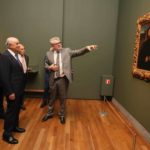El Prado rediscovers Lorenzo Lotto, the most modern of the Renaissance portrait painters
BBVA Group Executive Chairman Francisco González and José Pedro Pérez-Llorca, the President of the Board of Trustees of the Museo del Prado, today inaugurated the first major exhibition dedicated solely to the portraits of Lorenzo Lotto. Jointly organized with the National Gallery of London, the show is exclusively sponsored by the BBVA Foundation.

Lorenzo Lotto was one of the most fascinating artists of the Renaissance. The variety of his portraits and the pains he took to capture the mood of his subjects made him the first modern portrait painter. However, until now, his work has failed to receive the recognition it deserves.
"Lotto is one of the most remarkable painters of the Renaissance and one of the most important portrait artists in the entire history of Western art. Titian may have been a better portrait painter than Lotto, but a Titian exhibit is more boring because of the enormous variety of resources that Lotto uses", says Miguel Falomir, director of the Museo del Prado and joint curator of the exhibition along with Enrico Dal Pozzolo of the University of Verona.
The exhibition, which is being held at the museum from June 19 to September 30, includes 38 paintings, 10 drawings and a print which show how the Italian artist departed from the prevailing conventions of the time by focusing on the character of his subjects using objects to represent their interests and hopes. The show also includes some 15 sculptures and objects similar to those represented in the portraits such as a 17th century rosary, a gold ring from the 14th century and a man’s lace and linen shirt (1650-1700).
Among the innovations introduced by Lotto is the portrait of a married couple together, accompanied by objects and elements that lend themselves to symbolic interpretation. Prior to this, Italian painting represented couples separately, one portrait for the man and another for the woman.
As Falomir notes, one of the examples of this new way of portraying couples is ‘Micer Marsilio Cassotti and his wife Faustina’, which is owned by the Hermitage in Saint Petersburg (Russia), where the couple is shown in the presence of a sardonic Cupid looking at the husband with a yoke around his neck, revealing Lotto’s own thoughts on marriage.
"He also worked using a horizontal format at a time when portraits were vertical. This allowed him to include objects that reflected the concerns of the subject and tell us about his life (...) He also helps us immerse ourselves in the social and material dimension of the world at the time", Falomir adds.
Another of Lotto’s fortes was crypto-portraits in which he portrays his subjects with the attributes of those they identify themselves with, be it a classical god such as Venus, a heroine or a saint to which they are devoted. There is a notable abundance of portraits of Dominicans featured with the attributes of the saints of the order. It is likely these were commissioned by their communities as “mirrors of virtue” of their members.
The exhibition ends with the oleographic testament of the Italian painter sealed with the “crane taking flight”, which symbolizes, according to Falomir “the desire of the soul to rise up toward the world of ideas.”